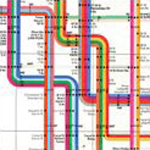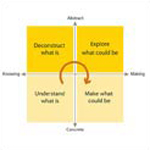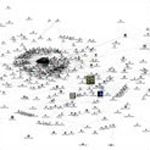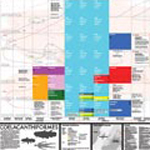KEYWORDS
Adjacencies, basemap, Coelacanth, Coelacanthiforme, information design, information graphics, stacking, superfice, visualization, VT-CAD
ABSTRACT
The composing of intelligible patterns from the noise of raw data is a hallmark of a good information designer. The most successful examples extract and present essential relationships in a coherent manner while limiting the obtrusiveness of accessory relationships. Effective results are self-evident whereby the information graphic is absorbed by the mind holistically. Such clarity often belies the intense efforts involved: like a baton race, all the work is concentrated to a point just before being passed on to the next participant in the informational relay. To this end, the designer applies a pattern or grid to position all the interrelational data fields. We call this process stacking: the mechanism for creating a beneficial complication whereby users see and understand holistically, which we consider to be cognitively superior to linear presentations.
The success of layered compositions depend on the appropriateness of the basemap (pictorial, relational, quantitative, or symbolic) and the quality of the designer’s integration. What can be correlated should be correlated. What cannot be interrelationally correlated, such as titles, labels, metadata, etc., should not interfere with the stacking grid since they introduce noise. Any “noisy” element is better brought “outside” the main grid and handled as an adjacency. Stacking interrelateable information fields through effective grid patterns, and supporting such a composition through non-interrelateable adjacencies, yields effective results in information graphics.
BIOGRAPHY
William M. Bevington currently serves as Associate Professor of Information Mapping in the School of Art, Media, and Technology at Parsons The New School for Design, The New School, New York. He formerly served as the Executive Director for Parsons Institute of Information Mapping, Chairman of the Communication Design department at Parsons School of Design, and various professorial and instructional roles at his Alma Mater, The Cooper Union for the Advancement of Science and Art. He is an information designer and information theorist specializing in creating tools for the rapid assessment of complex data. His first significant project was the Blackout Procedures Manual for Con Edison in 1983, and the last was a major Geospatial Media Mash-up Tool under U.S. government contract entitled the Geospace and Media Tool (GMT). Mr. Bevington has developed toolsets for transit systems applications, stock trading applications, and health management tools as a principle designer at Spire Integrated Design, New York. He has lectured worldwide, illustrated Graphic Designers Production Handbook, co-authored Working with Graphic Designers and Designing with Type with Jim Craig. He is also the author of Typography: The Principles, A Basic Guide to Using Type published by The Cooper Union.
William A. Anderson is an undergraduate student at Parsons The New School for Design pursuing his BFA in Communication Design. His focus is on information and interactive design, and he possesses a deep interest in design methodology. The Coelacanthiforme project featured in this paper was developed as part of an assignment in an information design class taught by Mr. Bevington. In addition to the project images, he contributed the associated captions and schematic plans, as well as the sections entitled “The Designer’s Learning Curve” and “Notes on Typographic Refinement.” In his spare time he teaches Children’s World Kanreikai Karate at the Society for Martial Arts Instruction.





